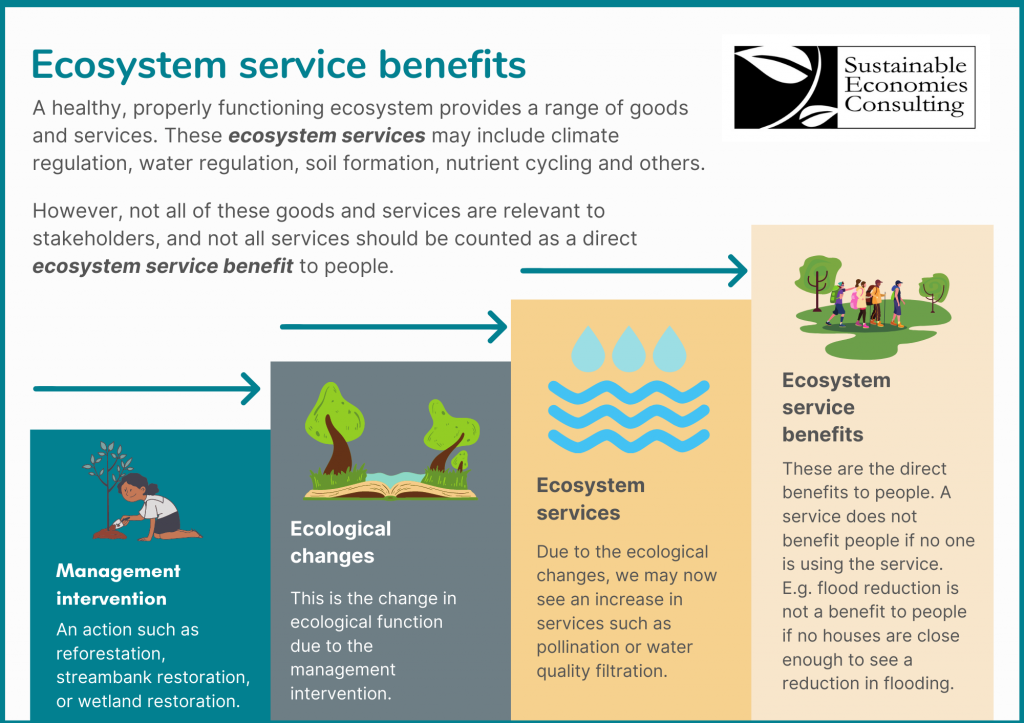
jon-flobrant-unsplash-WHO-WE-HELP-nonprofits-scaled
By Elizabeth Schuster, Environmental Economist
Introduction
Since the late nineties, the interest in putting a dollar value on nature has increased rapidly. Proponents of this approach argue that if no value is placed on nature, it is assumed to have zero value. Valuing nature gets it a seat at the table in policy discussions.
Sometimes it is true that putting a dollar sign on nature shows that habitat can be an investment. For instance, it’s great for your cost-benefit analysis if you can show that a restored wetland will reduce flood damages to surrounding homes by $100,000 per flood event. And it makes it easier to get funding for your native pollinator habitat program if you can demonstrate the resulting boosts to agricultural yields will amount to millions annually.
In other cases, framing values in monetary terms might not be necessary. Non-monetary metrics also can be useful to inform decisions. Examples include:
- Recent studies showing that exposure to nature can improve academic learning for school-aged children have spurred conversations about more green space in urban areas,
- As nuisance flooding grows worse in coastal areas, there is interest in using nature-based solutions to reduce the number of days or hours a road is closed due to flooding,
- New analysis suggests that natural amenities can play a role in healthy local economies and employee retention in small cities.
All of that sounds positive, right? Having more data on the value of nature undoubtedly helps make more informed decisions about tradeoffs. In a recent webinar, Justin Johnson, Assistant Professor of Economics at the University of Minnesota, noted that the global economy stands to lose $10 trillion by 2050 if actions are not taken to address climate change. In an alternative scenario, investing in global conservation would lead to an $11 billion net benefit to the economy.
Johnson added that today we have enough high-resolution data to meaningfully inform policy around nature’s benefits related to coastal protection, carbon storage, marine fisheries, water yield, and pollination.
What’s the problem?
What’s the problem, then? The issue is when we exaggerate the benefits that nature provides to people from specific projects or programs.
Figure one shows the process of how a management intervention leads to an improvement in ecological function, which leads to an increase in ecosystem services, which can result in more benefits to people.

Figure 1. The process of how a management intervention can lead to an increase in ecosystem service benefits to people.
In practice, it is challenging to access the data needed to quantify how many people are directly benefitting from a specific management intervention. It’s even harder to demonstrate how much people are benefitting from that intervention.
Sure, there are exceptions. It’s easy to count the number of fish harvested by a commercial fisherman (if they’re willing to share their data!) and how many visitors go to a state park (if they have a welcome center and are tracking number of visitors). In most other cases, it is resource intensive to do the analysis to show the number of people benefiting and level of impact on those people.
What happens when we still try to show that nature benefits people?
What happens in cases where there is no directly quantifiable benefit to people from nature in a given geography for a particular habitat type, but we still try to show that nature benefits people? Sadly, this happens a lot by well-intentioned experts who want to create a narrative about how nature benefits people.
- Exaggerating our baseline level of benefits makes it harder to show incremental improvements over time. For example, if we claim a high level of benefits to people from wetlands in our watershed at the start of a program, and then we get a grant and invest $1MM into wetland restoration. We may find that five years later we see no increase in benefits – because we started from an exaggerated baseline.
- Overly optimistic estimates around the potential benefits to people from a proposed ecological project can lead to poor project design. Projects need to be designed with certain goals in mind. A land preservation or ecological restoration project will be sited and designed differently if the goal is flood reduction, water quality filtration, biodiversity, or recreation. Being honest and realistic about the potential benefits you expect to see will help you design better projects and make you more likely to achieve your desired results.
- Unsubstantiated claims about benefits to people put you at risk of not making informed decisions around site selection. If you are trying to prioritize where to invest resources in ecological restoration and land preservation in a watershed. If we don’t have good data on the various benefits to people from forested land, wetlands, riparian corridors and streams, then you are doing nothing more than guessing. If your hope is to inform and prioritize projects based upon benefits to people, then, you need data. Otherwise, you have a high risk of choosing sites where there are no benefits to people – we see this especially in rural watershed.
- If there are no benefits to people, then you waste time and resources trying to quantify them. If your organization wants to protect and improve habitat for biodiversity in the state, it may actually be more effective to do a spatial analysis of biodiversity hot spots. Then overlay that with a map of recreation sites. Then you can seek win-wins, where people may benefit from wildlife viewing, but you don’t need to force a benefit if the link is loose.
Conclusion
In conclusion, as conservation managers, we often face situations where we want to translate the benefits to communities from our ecological project. We could pull together the large budget needed to do the analysis and risk that the study concludes that the benefits to people are negligible, based upon the data available.
Or we could make some assumptions and do a back-of-the-envelope-calculation. Here, you may be fortunate and get a more favorable answer, but you end up with poor quality data. And if we have very poor-quality data, then we’re not meeting our initial objective of making more informed decisions around the tradeoffs of whether (and where) to invest in nature.
This can lead to a lack of trust and lower credibility for researchers making claims about the value of nature. And for nonprofits, if they consistently market benefits to people from nature with insufficient data to back up claims, it creates a lack of transparency and loss of trust with your constituents.
Let’s do better. Sometimes nature should be protected for nature’s sake and we don’t always need to claim it benefits people. And in cases where nature does benefit people, let’s aim for using more thoughtful analysis to prioritize our investments in nature so we can see more win-wins for society and ecosystems.




